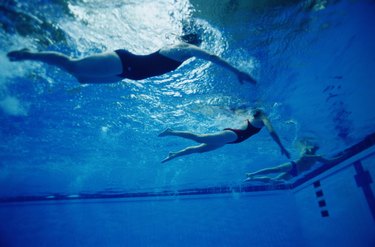
You've probably heard that swimming is a good way to improve your lung capacity, particularly if you have asthma or other breathing complications. However, in some cases, swimming can actually result in lung tightness. If this happens to you, it's important to identify the cause of your breathing problems in order to better treat and prevent them in the future.
Reasons for Lung Tightness
Video of the Day
The tightness of the lungs you may experience after swimming can come from exercise-induced bronchoconstriction, exercise-induced asthma or swimming-induced pulmonary edema. Exercise-induced bronchoconstriction and exercise-induced asthma, or EIB and EIA, respectively, occur thanks to the narrowing of the bronchial airways during your workout. You don't have to have asthma to experience EIB. Swimming-induced pulmonary edema, or SIPE, on the other hand, is a potentially serious condition that happens when your blood leaks out its red cells and proteins from your lungs to other organs in your body. The major factor in diagnosing SIPE is that it is triggered when you are under water.
Video of the Day
Symptoms To Watch Out For
Symptoms of tightness of the lungs after swimming include wheezing, chest tightness and coughing. If the symptoms are the result of exercise-induced bronchoconstriction or asthma, these usually come on right after you've finished exercising and can last for up to 30 to 60 minutes. In those with SIPE, symptoms can also include a cackling sound in the lungs and coughing up a pink, frothy-looking substance. SIPE symptoms can last for up to a week.
How It's Treated
EIB and EIA can be treated by exercising in warmer environments, swimming in short spurts rather than long distances, and using an inhaler. Ask your doctor what medication might work best for you. Those with SIPE, on the other hand, should completely avoid working out in wet areas, including the swimming pool. Some patients might even need to be put on supplemental oxygen until the symptoms are eliminated.
Preventing Lung Tightness After Swimming
To prevent tightness of the lungs after swimming in the future, it's best to first identify the source of your shortness of breath. Go to a doctor as soon as possible. Those with EIB and EIA might need to work out with an inhaler in hand and avoid swimming long distances; instead, swim in short, more intense spurts. If you do have SIPE, then it's best to avoid swimming altogether and choose an alternative form of exercise.
- Who Says I Can't: Swimming is Fantastic for the Lungs
- Partners Healthcare Asthma Center: Exercise and Asthma
- Slow Twitch: Swimming Induced Pulmonary Edema (SIPE)
- National Center for Biotechnology Information: Swimming-induced pulmonary edema: clinical presentation and serial lung function.
- American Family Physician: Exercise-Induced Bronchoconstriction: Diagnosis and Management
- American Family Physician: Management of Swimming-Induced Pulmonary Edema